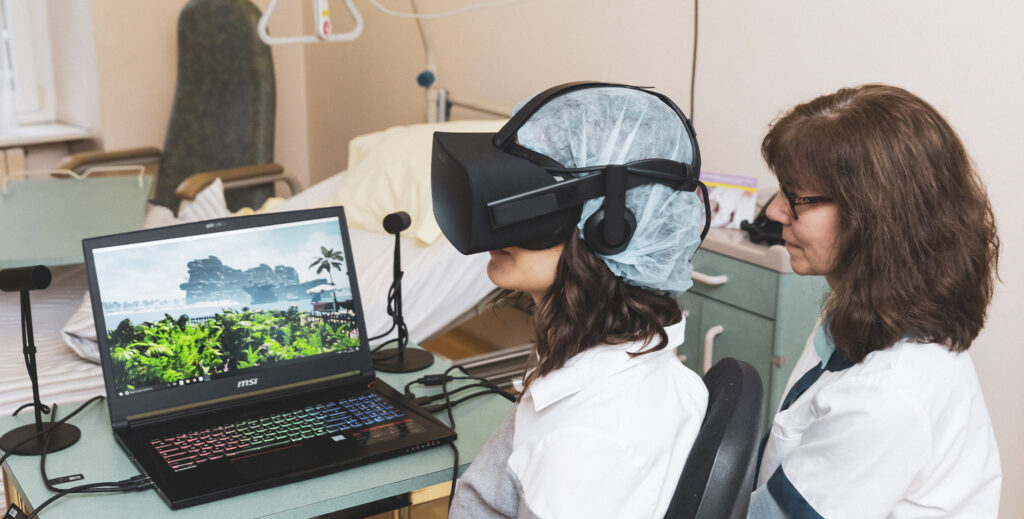Used for treatment in Western societies for at least 200 years, hypnosis didn’t wait for the 21st century to shine. For a long time, popular culture relegated the practice to the realm of entertainment, but its therapeutic value is once again attracting attention. Numerous studies now confirm the effectiveness of this non-medicinal technique in combating pain and anxiety. How does therapeutic hypnosis work? In this article, we explain the altered state of consciousness on which the approach is based, the effects on the body and the benefits of combining it with virtual reality.
The altered state of consciousness: a natural order
The notion of consciousness corresponds to our permanent state of alertness when we are awake. Neuroscientists agree that there are three components: wakefulness, realistic perception of the environment and of ourselves. Under normal circumstances, these characteristics are active and associated: we analyse and understand what is happening around us. If one or other of the components diminishes, fades or dissociates, we enter an altered state of consciousness.
From then on, the altered state of consciousness corresponds to an intermediate position between full consciousness and sleep (where we “lose consciousness”), a stage where the doors to the unconscious open wide. The unconscious is characterised by our intuitions, our emotions, our memories, our dreams, our buried patterns… Hence the value of hypnosis in a therapeutic context.
Throughout the hypnotic experience, you never lose your free will; you remain present in the moment. During a session, the practitioner guides you into a state of deep relaxation, often described as a reverie or trance. Your mind becomes exceptionally receptive to the hypnotherapist’s verbal suggestions. Using visualisation, concentration and breathing techniques, your mind calms down and you enter this famous altered state of consciousness.
Contrary to preconceived ideas, altered consciousness is not synonymous with loss of control. Therapeutic hypnosis aims to provide deeper access to the unconscious, where unwanted behaviour and thoughts can be addressed and modified. In this sense, there is nothing magical about hypnosis; it is based on a natural way of functioning that most of us experience on a daily basis. In therapeutic hypnosis, this state is intentionally induced to promote healing and positive change.

Hypnotic suggestions: the hypnosis session in practice
The effects of therapeutic hypnosis on your organism
In a therapeutic hypnosis session, your sensory journey begins with mental imagery suggestions. Even if the situation is fictitious, the sensations aren’t imaginary for your brain: your perceptions are real. The study by Heidi Jiang et al. published in Oxford University Press perfectly illustrates the activation of the brain areas at work.
Hypnosis plunges you into a state halfway between wakefulness and sleep. The experience results in a reduction in the activity of the brain regions involved in the subjective perception of pain. Hypnosedation uses this effect to improve patient comfort during surgical or endoscopic procedures.
The scope of therapeutic hypnosis and its effects on the body are numerous:
- reduced stress and anxiety: by encouraging deep relaxation, hypnosis stimulates the parasympathetic nervous system. As a result, stress, anxiety and muscular tension are reduced;
- improved sleep: by inducing a state of relaxation conducive to falling asleep, therapeutic hypnosis treats sleep disorders such as insomnia;
- pain management: whether for painful medical procedures or to manage chronic pain, the effectiveness of hypnosis has been proven. Many hospitals use hypnosedation to reduce the need for general anaesthesia;
- boosting self-confidence: by replacing negative ideas with positive, constructive thoughts, therapeutic hypnosis offers a calmer relationship with oneself;
- behavioural changes: sessions are effective in treating problems such as smoking, weight loss and other behaviours by positively influencing the patient’s habits and reactions;
- improved concentration and creativity: hypnotic suggestions help to improve concentration, creativity and problem-solving by eliminating mental distractions;
- reduction in psychosomatic symptoms: working with a hypnotherapist can reduce the symptoms associated with psychosomatic disorders, such as headaches, abdominal pain or gastrointestinal problems, by targeting the underlying mental aspects;
- boosting the immune system: among the incredible benefits of therapeutic hypnosis, studies suggest that it boosts the immune system by reducing stress, which undeniably has a positive impact on overall health;
- managing mood disorders: in conjunction with other therapies, hypnosis sessions help to treat depression, anxiety, phobias and other mood disorders.

Missed opportunity: when hypnosis doesn’t work
As effective as hypnosis can be, it doesn’t always work miracles. Receptivity to this therapeutic technique varies from person to person, so results cannot be anticipated.
Some people are naturally more inclined to enter an altered state of consciousness, which contributes to the success of the experience. The expectation of immediate benefits can also create an imbalance, especially as several sessions are often necessary to achieve lasting results.
In addition, certain mental health problems, such as schizophrenia or other psychotic disorders, may require a different approach. Furthermore, trust and the relationship between practitioner and patient play an essential role in the success of the practice. Nevertheless, it should be remembered that the practice has no adverse effects.

Therapeutic hypnosis and virtual reality: a duo that increases the benefits tenfold
Hospitals are well aware of the benefits of hypnosis sessions, but they are not always able to keep up with the pace. Rather than leaving the benefits of this technique on the sidelines, the medical team can rely on ergonomic and effective tools to assist them. Therapeutic virtual reality offers a way of taking over from medical staff and helping patients to feel better.
For some years now, immersive experiences have been an integral part of the treatment process, providing comfort and reassurance. Virtual reality (VR) combines several principles to achieve deep relaxation:
- realistic 3D worlds with high graphic quality;
- hypnotic speeches specially designed by professionals;
- a unique sound atmosphere based on the benefits of music therapy;
- targeted breathing exercises to help manage stress and emotions.
Therapeutic virtual reality creates an engaging and fun environment to help patients overcome the constraints of hospital life, the anxiety associated with an operation and to ease their pain. The multisensory experience invites patients to let go, to disconnect, to move beyond a sometimes anxiety-provoking environment.
Therapeutic virtual reality also provides companies with a breath of fresh air in their hectic daily lives. Employees can take advantage of a moment of calm to relieve the professional pressure that sometimes hinders creativity and self-fulfilment.
What’s more, this approach is particularly effective for users who find it hard to visualise hypnotic suggestions mentally: immersions in VR make them more tangible. By reducing mental blocks, this combination of hypnosis and virtual reality is suitable for all audiences.
The altered state of consciousness, a fundamental pillar in understanding how therapeutic hypnosis works, plunges us halfway between wakefulness and sleep. During this experience, stress, anxiety and pain fade away and the unconscious mind emerges. Given these benefits, health professionals and businesses alike are turning to hypnosis to bring comfort and well-being. To facilitate access to the practice, virtual reality offers a device combining several therapeutic techniques. To discover the effectiveness of this solution with your own eyes, don’t hesitate to ask for a demonstration.
Sources :
- Inserm, À méditer – C’est quoi un état de conscience modifié ? ;
- Dossier Inserm, Évaluation de l’efficacité de la pratique de l’hypnose. Expertise scientifique réalisée par l’unité INSERM U1178 à la demande du ministère de la Santé (Direction générale de la Santé), juin 2015 ;
- Heidi Jiang, Matthew P White, Michael D Greicius, Lynn C Waelde, David Spiegel, Brain Activity and Functional Connectivity Associated with Hypnosis, août 2017 ;
- Trevor Thompson, Devin B Terhune, Charlotte Oram, Joseph Sharangparni, Rommana Rouf, Marco Solmi, Nicola Veronese, Brendon Stubbs, The effectiveness of hypnosis for pain relief: A systematic review and meta-analysis of 85 controlled experimental trials, avril 2019.







